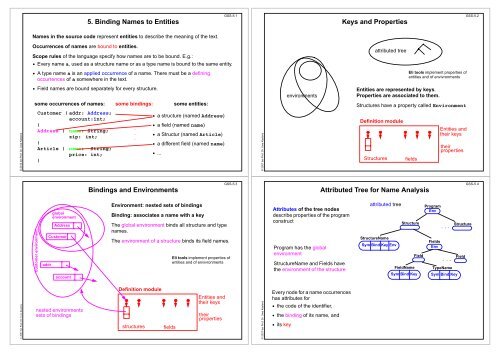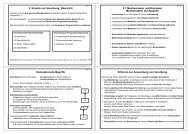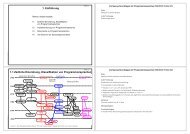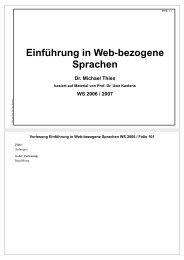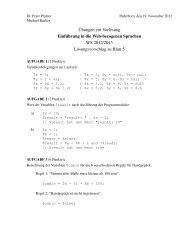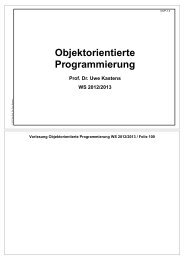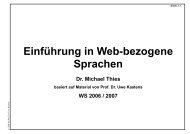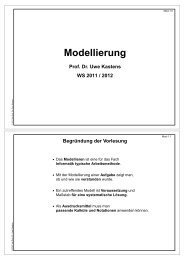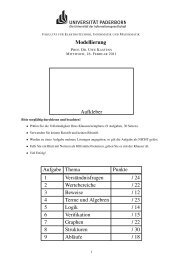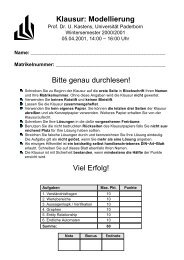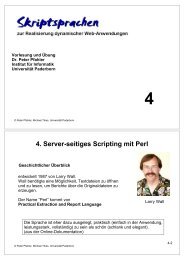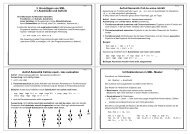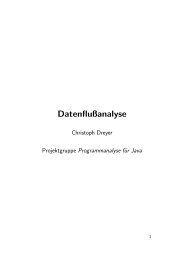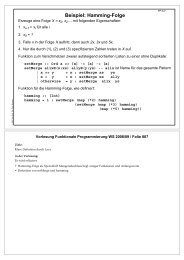5. Binding Names to Entities Keys and Properties Bindings and ...
5. Binding Names to Entities Keys and Properties Bindings and ...
5. Binding Names to Entities Keys and Properties Bindings and ...
You also want an ePaper? Increase the reach of your titles
YUMPU automatically turns print PDFs into web optimized ePapers that Google loves.
<strong>5.</strong> <strong>Binding</strong> <strong>Names</strong> <strong>to</strong> <strong>Entities</strong><br />
GSS-<strong>5.</strong>1<br />
<strong>Keys</strong> <strong>and</strong> <strong>Properties</strong><br />
GSS-<strong>5.</strong>2<br />
<strong>Names</strong> in the source code represent entities <strong>to</strong> describe the meaning of the text.<br />
Occurrences of names are bound <strong>to</strong> entities.<br />
Scope rules of the language specify how names are <strong>to</strong> be bound. E.g.:<br />
• Every name a, used as a structure name or as a type name is bound <strong>to</strong> the same entity.<br />
attributed tree<br />
• A type name a is an applied occurrence of a name. There must be a defining<br />
occurrences of a somewhere in the text.<br />
Eli <strong>to</strong>ols implement properties of<br />
entities <strong>and</strong> of envivronments<br />
© 2012 bei Prof. Dr. Uwe Kastens<br />
• Field names are bound separately for every structure.<br />
some occurrences of names: some bindings: some entities:<br />
Cus<strong>to</strong>mer ( addr: Address;<br />
account:int;<br />
)<br />
Address (<br />
name: String;<br />
zip: int;<br />
)<br />
Article ( name: String;<br />
price: int;<br />
)<br />
.<br />
.<br />
.<br />
• a structure (named Address)<br />
• a field (named name)<br />
• a Structur (named Article)<br />
• a different field (named name)<br />
• ...<br />
© 2007 bei Prof. Dr. Uwe Kastens<br />
environments<br />
<strong>Entities</strong> are represented by keys.<br />
<strong>Properties</strong> are associated <strong>to</strong> them.<br />
Structures have a property called Environment<br />
Definition module<br />
Structures<br />
fields<br />
<strong>Entities</strong> <strong>and</strong><br />
their keys<br />
their<br />
properties<br />
<strong>Binding</strong>s <strong>and</strong> Environments<br />
GSS-<strong>5.</strong>3<br />
Attributed Tree for Name Analysis<br />
GSS-<strong>5.</strong>4<br />
Cus<strong>to</strong>mer environment<br />
addr<br />
global<br />
environment<br />
Address<br />
Cus<strong>to</strong>mer<br />
account<br />
Environment: nested sets of bindings<br />
<strong>Binding</strong>: associates a name with a key<br />
The global environment binds all structure <strong>and</strong> type<br />
names.<br />
The environment of a structure binds its field names.<br />
Eli <strong>to</strong>ols implement properties of<br />
entities <strong>and</strong> of envivronments<br />
Attributes of the tree nodes<br />
describe properties of the program<br />
construct<br />
Program has the global<br />
environment<br />
StructureName <strong>and</strong> Fields have<br />
the environment of the structure<br />
attributed tree<br />
Program<br />
Env<br />
Structure<br />
. . .<br />
Structure<br />
StructureName<br />
Fields<br />
Sym Bind Key Env<br />
Env<br />
Field<br />
. . .<br />
Field<br />
FieldName TypeName<br />
Sym Bind Key Sym Bind Key<br />
© 2007 bei Prof. Dr. Uwe Kastens<br />
nested environments<br />
sets of bindings<br />
Definition module<br />
structures<br />
fields<br />
<strong>Entities</strong> <strong>and</strong><br />
their keys<br />
their<br />
properties<br />
© 2007 bei Prof. Dr. Uwe Kastens<br />
Every node for a name occurrences<br />
has attributes for<br />
• the code of the identifier,<br />
• the binding of its name, <strong>and</strong><br />
• its key
Attributes, Environments, <strong>and</strong> <strong>Keys</strong><br />
GSS-<strong>5.</strong>5<br />
Environment Module<br />
GSS-<strong>5.</strong>6<br />
© 2007 bei Prof. Dr. Uwe Kastens<br />
Cus<strong>to</strong>mer environment<br />
addr<br />
global<br />
environment<br />
Address<br />
Cus<strong>to</strong>mer<br />
account<br />
nested environments<br />
sets of bindings<br />
attributed tree<br />
StructureName<br />
Sym Bind Key Env<br />
structures<br />
Structure<br />
FieldName<br />
Sym Bind Key<br />
fields<br />
Field<br />
Program<br />
Env<br />
Fields<br />
Env<br />
. . .<br />
. . .<br />
TypeName<br />
Sym Bind Key<br />
Structure<br />
Field<br />
<strong>Entities</strong> <strong>and</strong><br />
their keys<br />
their<br />
properties<br />
© 2007 bei Prof. Dr. Uwe Kastens<br />
Implements the abstract data type Environment:<br />
hierarchally nested sets (tree) of bindings (name, environment, key)<br />
Functions:<br />
NewEnv ()<br />
creates a new environment e, that is the root of a new tree;<br />
used in root context<br />
NewScope (e 1 ) creates a new environment e 2 that is nested in e 1 .<br />
Every binding of e 1 is a binding of e 2 , <strong>to</strong>o, if it is not hidden<br />
by a binding established for the same name in e 2 ;<br />
used in range context<br />
BindIdn (e, id)<br />
<strong>Binding</strong>InEnv (e, id)<br />
<strong>Binding</strong>InScope (e, id)<br />
creates a new binding (id, e, k), if e does not yet have a<br />
binding for id; k is then a new key for a new entity;<br />
the result is in both cases the binding (id, e, k);<br />
used for defining occurrences.<br />
yields a binding (id, e 1 , k) of e oder of a surrounding<br />
environment of e; if there is no such binding it yields No<strong>Binding</strong>;<br />
used for applied occurrences<br />
yields a binding (id, e, k) of e, if e directly contains such a<br />
binding; No<strong>Binding</strong> otherwise; e.g. used for qualified names<br />
GSS-<strong>5.</strong>8<br />
Example: <strong>Names</strong> <strong>and</strong> <strong>Entities</strong> for the Structure Genera<strong>to</strong>r<br />
Abstract syntax<br />
RULE: Descriptions LISTOF Import | Structure END;<br />
RULE: Import ::= 'import' Import<strong>Names</strong> 'from' FileName<br />
END;<br />
RULE: Import<strong>Names</strong> LISTOF ImportName END;<br />
RULE: Structure ::= StructureName '(' Fields ')'<br />
END;<br />
Root of the<br />
environment hierarchy<br />
Fields play the<br />
role of a Range.<br />
The inherited<br />
computation of Env is<br />
overridden.<br />
Computation of Environment Attributes<br />
SYMBOL Descriptions INHERITS RootScope END;<br />
SYMBOL Fields INHERITS RangeScope END;<br />
GSS-<strong>5.</strong>9<br />
RULE: Structure ::= StructureName '(' Fields ')'<br />
COMPUTE<br />
Fields.Env = StructureName.Env;<br />
END;<br />
RULE: Fields LISTOF Field END;<br />
© 2007 bei Prof. Dr. Uwe Kastens<br />
RULE: Field ::= FieldName ':' TypeName ';'<br />
END;<br />
RULE: StructureName ::= Ident END;<br />
RULE: ImportName ::= Ident END;<br />
RULE: FieldName ::= Ident END;<br />
RULE: TypeName ::= Ident END;<br />
Different nonterminals for identifiers in different roles,<br />
because different computations are expected, e.g. for<br />
defining <strong>and</strong> applied occurrences.<br />
© 2012 bei Prof. Dr. Uwe Kastens<br />
Each structure entity<br />
has an environment<br />
as its property.<br />
It is created only once<br />
for every occurrence of<br />
a structure entity.<br />
That environment is<br />
embedded in the<br />
global environment.<br />
In that environment the<br />
field names are bound.<br />
SYMBOL StructureName COMPUTE<br />
SYNT.GotEnvir =<br />
IF (EQ (GetEnvir (THIS.Key, NoEnv), NoEnv),<br />
ResetEnvir<br />
(THIS.Key,<br />
NewScope (INCLUDING Range.Env)));<br />
SYNT.Env =<br />
GetEnvir (THIS.Key, NoEnv)
Defining <strong>and</strong> Applied Occurrences of Identifiers<br />
GSS-<strong>5.</strong>10<br />
Computations<br />
IdentOcc for all<br />
identifier occurrences.<br />
CLASS SYMBOL IdentOcc: Sym: int,<br />
CLASS SYMBOL IdentOcc COMPUTE<br />
SYNT.Sym = TERM;<br />
END;<br />
All defining occurrences<br />
bind their names in the<br />
next enclosing Range<br />
SYMBOL StructureName<br />
INHERITS IdentOcc, IdDefScope END;<br />
SYMBOL ImportName<br />
INHERITS IdentOcc, IdDefScope END;<br />
SYMBOL FieldName<br />
INHERITS IdentOcc, IdDefScope END;<br />
© 2012 bei Prof. Dr. Uwe Kastens<br />
Bind an applied<br />
occurrence of an<br />
identifier in the enclosing<br />
environment;<br />
report an error if there is<br />
no valid binding.<br />
SYMBOL TypeName<br />
INHERITS IdentOcc, IdUseEnv, ChkIdScope END;


